Charts Hill Golf Club battles the weather
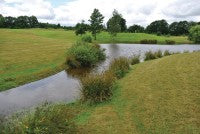 Apart from 'come on Andy', what three words will most remind us of summer 2012? How about 'since records began'? In a year that started with the single word 'drought' echoing the length and breadth of the country, with water restrictions a nailed-on certainty, weeks, nay months, of non-stop rain have left pretty well everywhere overflowing. Turf has surely never been so verdant.
Apart from 'come on Andy', what three words will most remind us of summer 2012? How about 'since records began'? In a year that started with the single word 'drought' echoing the length and breadth of the country, with water restrictions a nailed-on certainty, weeks, nay months, of non-stop rain have left pretty well everywhere overflowing. Turf has surely never been so verdant.
The Chart Hills course, at Biddenden in the Weald of Kent, has been in the top one hundred UK courses ever since it was first constructed in 1993. It has always been one to catch the eye, not least because it was the first design endeavour by Nick Faldo, whose aim was to create an 18-hole championship course with challenging pro tees and tough yardage. There's no denying that this parkland style course, with open aspect and tree-lined fringes, has the perfect combination of delightful views and genuine golfing test. The cliché risk and reward is never truer than when playing a round here. That's why many a travelling golfer seeks it out.
The course, one of four owned by the Leaderboard Group, spans 220 acres. It is built on a predominantly clay base so drainage is not the easiest and needs help, especially over winter. These are topsy-turvy times weather-wise though, and last winter was the driest ever at Chart Hills, so it was golf that flowed not surface water. 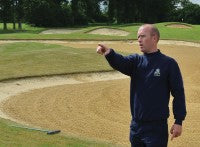 Twelve months earlier, in the winter of 2010-11, snow and surface water meant that the course had to close for thirty-seven days. Catch basins beneath the fairways flow into man-made creeks then on to one of four man-made lakes, which are both playing hazard and irrigation source.
Twelve months earlier, in the winter of 2010-11, snow and surface water meant that the course had to close for thirty-seven days. Catch basins beneath the fairways flow into man-made creeks then on to one of four man-made lakes, which are both playing hazard and irrigation source.
Dry winter or wet summer, top greenkeepers like the Deputy Course Manager at Chart Hills, Ben Abbott, have had to adapt, much like the turf under their care.
"I've never known grass grow like it has done this summer because of the excessive rainfall," said Ben. "We've spent a lot more money on diesel and man hours because of the extra mowing that we've had to do. I'd estimate that probably between thirty and forty percent more than in a normal summer."
"It's the semi-roughs that are causing the biggest problem. Normally we'd need only trim it once every other week. This year, we've been doing it once, sometimes twice, a week just to keep on top of it. There's no question it's an absolutely necessary task in order to keep speed of play at reasonably levels. Players don't want to spend too long searching for balls, and the semi-rough grass would put a real brake on play if we let it grow at the speed it has been, since spring, for more than a few days."
"For tees and greens, cutting has been pretty much as normal, perhaps a little up on normal, but the growth inhibitor we spray on the greens - PrimoMaxx - has been a help. It shortens the plant and thickens the sward, but the real benefit to the golfer is that greens play the same in the evening as they do in the morning. You don't get that fluffy between cuts growth that can change the speed."
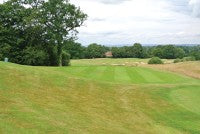
Very unusually, fusarium has become a summer problem on the greens this year, which can only be put down to the excessive moisture levels and high disease pressure over the last few months. Ben says they have a programme of preventative spraying in place, using mixtures from fungicide products called Heritage Maxx and Instrata, which has three active contact and systemic ingredients. He was confident this would keep the problem at bay.
The tees have suffered a bit over the past couple of years, Ben also says, though less specifically because of the recent excessive rain. They've been conducting a programme to improve them by re-seeding with a denser creeping perennial ryegrass, which produces many plants from a single seed and has a better recovery characteristic. Results have been impressive.
"The topsy-turfy climate and abnormally wet summer are having a marked effect on the way we schedule our work," said Ben. "The extra mowing work has meant that various renovation programmes are on hold, notably for the course's bunkers. Cutting grass has taken almost total precedence this summer. The course looks 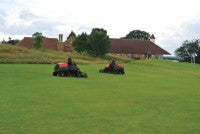 amazingly healthy though and it's in fantastic condition."
amazingly healthy though and it's in fantastic condition."
"You'd never know it was July. It looks more like May or September when, in normal years, it's the best time to play golf here. It's so lush everywhere at a time when we should be irrigating to keep it growing.
The golfers here understand that our main task is to present the course to the highest possible level and, this year, that means mowing, mowing, and more mowing. The constant rain can be quite demoralising, but it's my job to keep everybody 'up for the job'. The reward to us as professionals is that many are saying that the course is looking absolutely marvellous, the best it has for years. We have to thank the weather for that."
The mowing regime at Chart Hills is generally, when time allows, to hand cut the greens, and most definitely for tournaments. Toro's pedestrian GM 1000s, with grooming system, do this. Four greenkeepers will take three hours to cut all 18 greens each morning. During the playing season, fairways are cut every Tuesday and Friday, and Jacobsen LFs are used for this.
As for the bunker work that's on hold, the main purpose of this is to renew sand and drainage. "Ideally, we would aim to do this on a rolling basis year on year, but  some of the bunkers have had no real attention since they were first constructed in 1993," said Ben.
some of the bunkers have had no real attention since they were first constructed in 1993," said Ben.
"Obviously, what we try to combat is contamination by rain washing out the sand and clay particles getting introduced. The drainage gets blocked with silt and this needs renewing. On average, we reckon the revamping of a bunker costs between £1,500 and £2,000 for labour and materials."
Some of the bunkers are being filled in to blend into the wild grasses because they seldom come into play. The upgrading programme was first begun back in 2004 when the course staged the Ladies English Open for the first time. The aim, once the rain and the mowing pressure have eased, is to refresh them all.
The Anaconda is the signature bunker to end all signature bunkers, and very much a design statement by Nick Faldo. It's a remarkable course feature and a daunting hazard to say the least, going on forever, nearly 280 yards in overall length. It takes one of the greenkeepers up to half an hour to rake it using a SandPro. When you have to hand rake and trim the edges for tournaments it can be quite testing to say the least. The honest truth is everyone that works on it takes a real pride in making it look as near perfect as possible. Like all bunkers it has a way of capturing you, only much more so.
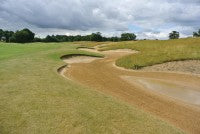
All bunkers are raked daily in summer, mostly by additional casual staff, whose other duties include fairway divoting. An extra nuisance to the bunker maintenance routine are the rabbits who perpetually disturb the sand by playing in it.
Originally, there had been over 130 bunkers around the course, but now 122 are in play, which is still a lot of sand - 3,212 tonnes is the exact figure Ben says, 493 of it in the Anaconda alone. Actually, eighteen full time staff should be on hand to cope with such a bunkered course according to a formula based on size of course and number of bunkers, so they work pretty hard to keep it looking so immaculate.
There are eleven full-time staff in the maintenance department, which includes irrigation technician and spray technician as well as greenkeepers.
Ben has been at the course since March 2003, when he moved from the Ridge Golf Club, which is just fifteen minutes away and where he was also Deputy Course Manager.
 One of his own project ideas has been to let the rough grow along the back of a number of bunkers, to add to their character, and to reduce a little of the maintenance work.
One of his own project ideas has been to let the rough grow along the back of a number of bunkers, to add to their character, and to reduce a little of the maintenance work.
"This is a championship golf course, not a pay and play," he said. "Nick Faldo designed it to be tough, yet beautiful. We are very proud of this and determined to keep it that way. We're always looking for improvements though."
"Those that have been introduced since I've been here include better trafficking of golfers and their carts by post and rope guidance to keep them from overdoing straight line wear and tear. It's important to keep the fescue rough as unspoilt as possible. It is pleasing to the eye and everything we can do to keep it that way is worthwhile."

Ben says that £50,000 is also being spent on upgrading the buggy tracks around the course. This is a two year project but, again, behind schedule by two or three months because of the weather. This involves fresh tarmacking of surfaces. Paying over £2,000 for seven-day membership, you expect comfortable passage around the course, and that's the reason for the upgrade.
There is also an ongoing project to keep under control the bullrushes in the creeks. They are delightful to look at, but a growing threat to drainage by impeding water flow and need to be kept in check.
Waterlogging can be a problem in parts of the fairways from time to time. The drainage set-up, installed at construction, does deal with most of the excess water, but some thought may now have to be given to installing secondary drainage. The estimated cost for this would be upwards of £200,000 and involve a certain amount of disruption, so this is an idea rather than a plan as yet.
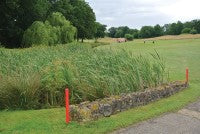 "We are finding that the wetting agent we use for greens and surrounds - Revolution - is serving us as well in times of surplus water as in drought conditions," said Ben. "It does just as good a job for us in the wet as in the dry, helping to take excessive water down and away from the top few inches."
"We are finding that the wetting agent we use for greens and surrounds - Revolution - is serving us as well in times of surplus water as in drought conditions," said Ben. "It does just as good a job for us in the wet as in the dry, helping to take excessive water down and away from the top few inches."
All aeration and decompaction work is done in-house, Groundsman and Wiedenmann Terra Spike being the equipment used. Greens and tees are hollow-cored periodically.
It seems a folly mentioning irrigation this year, but there are 1200 heads around the course. The Toro Site Pro system they use allows individual operation for each hole. This year, Ben says it has only been used a dozen times at most, which is a record low by a long way.
Chart Hills' records began in 1993. Some of the recent figures make interesting reading. In June this year, 85mm of rainfall was recorded on the course and, in April, 115mm, which was the wettest April since the course opened. Last year, by contrast, April rainfall measured just 0.5mm. The total for the whole of 2011 was 500mm. In the first six months of 2012, 338mm had been recorded.
The economics of the private golf course is tough these days, and it's difficult to keep them prospering. The recession hasn't helped and, with so many courses offering cheap deals, retaining membership levels is hard. Courses like Chart Hills will always have the bonus of attracting the discerning, travelling golfer bent on playing the best, tough courses. Faldo's aim - despite the weather - does seem to be holding up in this corner of Kent.
What's in the shed?
Tractors and loaders
Kubota R410B
John Deere 855
New Hooland TC40
John Deere 5515
Fairway mowers
Jacobsen LF3400 x 2
Ride-on greens mowers
Jacobsen G'King IV x 3
Surrounds mowers
Jacobsen Tri-King x 2
Pedestrian mowers
Toro Greensmaster 1000 x 5
Baroness LM56 GF x 4
Semi-rough mowers
Lastec Articulator x 2
John Deere Batwing WAM
John Deere 1445
Utility vehicles
John Deere Gator (4x2) x 3
John Deere E Gator x 2
John Deere Pro Gator x 2
Club Car Golf Buggy
Bunker rakes
Toro Sandpro 3020 x 2
Aeration equipment
Groundsman 8120 CTM
Groundsman 460SDR
Wiedenmann Terra Spike
Double Quick 6 Slitter
Cushman GA60
Trailers
Griffiths GCM 2.0
Warwick Tipping
Ifor Williams Easy Load Highlift
Hover mowers and strimmers
Allen 453 x 4
Allen 446
Blowers
Honda UMK x 8
Stihl Back Pack x 8
Chainsaws
Husqvarna 262
Stihl 044
Echo CS 3400
Stihl MS 200
Stihl MS 660
Hedgecutters
Tanaka TPH230S
Stihl
Spraying Equipment
Bargam Shrouded Unit
John Deere HD200
Fantini Mixer Tank
Knapsack sprayers x 4
Seeding Equipment
Gill Seeder
BLEC Disc Seeder
Lesco Drop Seeder
BRECO Disc Spreader
Scotts Acupro 2000 x 2
Topdressers
Toro Mounted
Tirfco
Ultra Disc Spreader
Leaf and Debris Collection
Wessex Leaf Sweeper
Trilo SU60 Vacuum
Construction Equipment
JCB 802
Stihl TS 400 Stonecutter
Wacker Palte VP1135
Belle 150 Cement Mixer
Gannon Box Blade HD315
Other
Otterbine Floating Pump
Ryan Turf Cutter
Tractor mounted post hole borer
12" Post Auger
24" Post Auger
AFT 845 Trencher
Sisis Veemo
Huxley Grainskeeper Brush
Thatchaway units x 6
Vibrating rollers x 6
Sarrel Rollers x 3
Dragbrushes x 2
